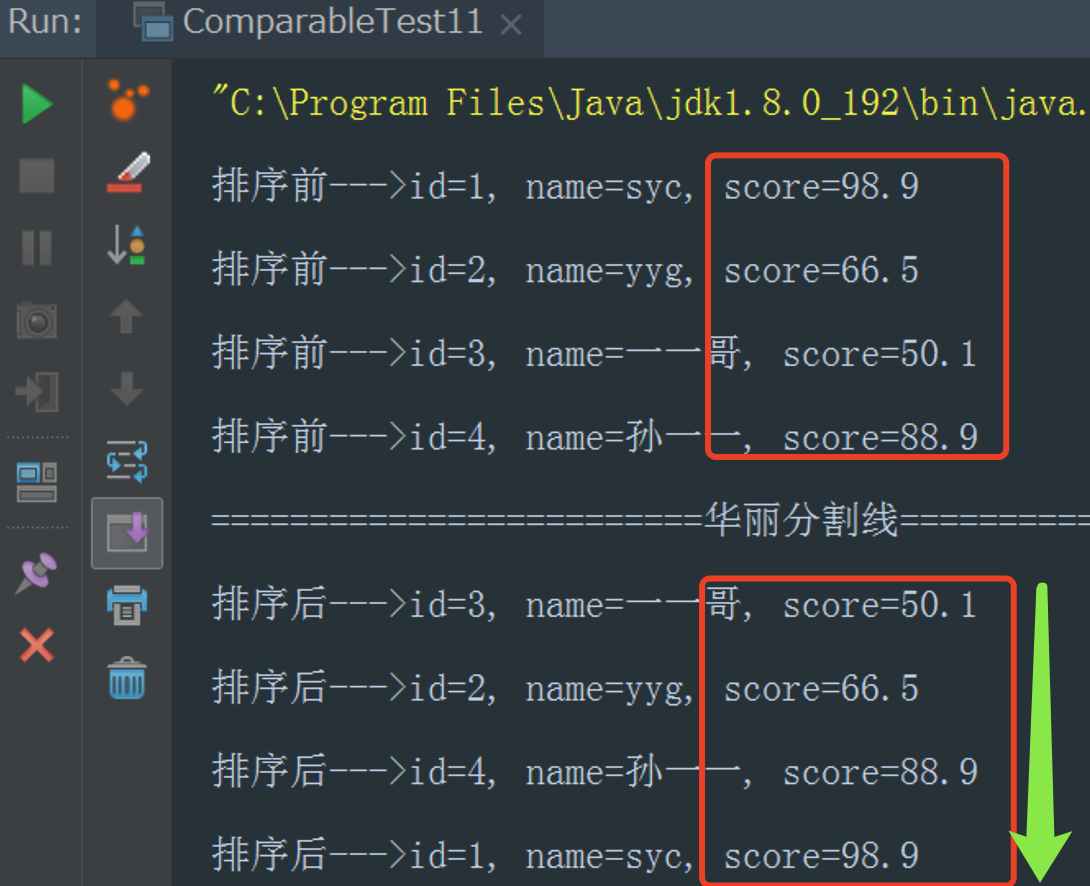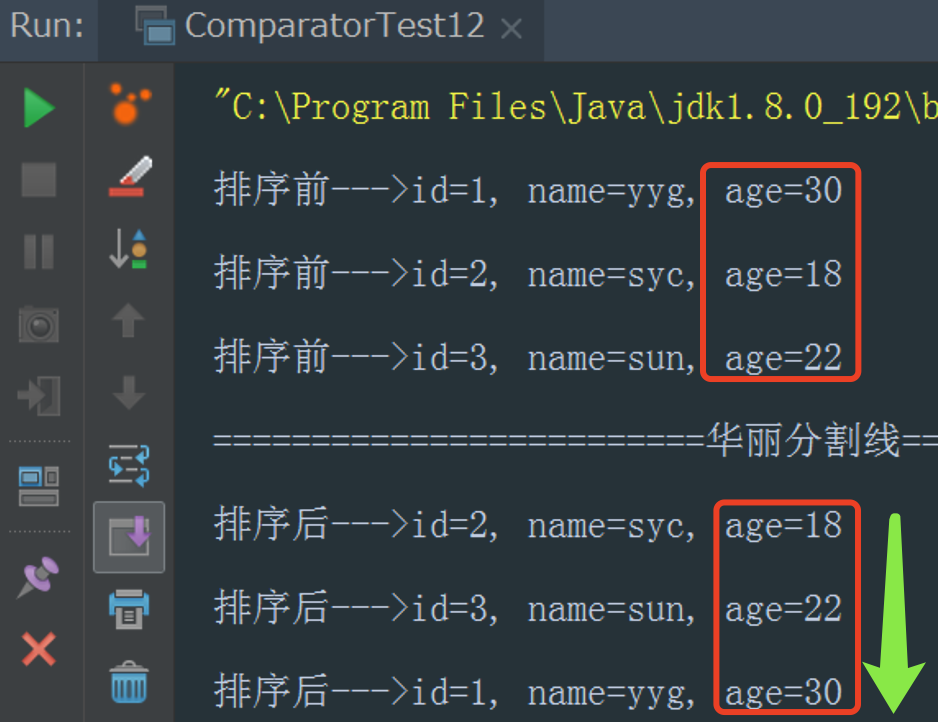一. 面试题及剖析
1. 今日面试题
我们在项目开发时,有时候会遇到列表搜索查询等效果,其中大部分都可以利用SQL语句来实现,但也有些特殊的搜索排序利用SQL是很难实现的,比如对中文进行排序。说到排序,你可能会想到很多排序算法,比如常见的冒泡排序、堆排序、插入排序等,但Java本身其实也提供了排序API,所以有时候面试官会提问这样的面试题:
说一下Java中的对象如何实现排序?
Java如何操作对象(bean)进行动态排序?
Java对实体类(bean)如何进行动态排序?
......
2. 题目剖析
今日这道面试题,其实考察的还是我们对Java中常用API的掌握情况,尤其是对Java对象的排序实现,比如按照类中的某一个属性(或多个属性)来对类的对象进行排序。
二. 参考答案
1. Java排序实现方式
要想实现对某个对象的排序,排序方式整体可以分为 自定义排序和实现Java中的比较器接口排序 这2种方式。
自定义对象排序:我们可以根据自定义对象的数据结构,自定义排序规则来实现。
实现Java中的比较器接口排序:可以实现Java中的两个常用接口,Comparable和Comparator。
在本文中,壹哥 主要带各位复习 Comparable 和 Comparator两个接口,并比较两者的差异,再利用这两个接口来实现排序案例。
2. Comparable接口
Comparable 是Java提供的进行自然排序的接口。Comparable接口会对实现该接口的每个类对象都强加一个整体排序,这个排序称为类的自然排序(默认为升序),所以一个类实现了Comparable接口,就意味着该类支持排序。一旦该类支持排序,那么存储了该类的List列表或Array数组就可以通过Collections.sort() 或 Arrays.sort() 方法进行自然排序。
Comparable 接口中只包括一个自然比较方法,源码如下:
public interface Comparable<T> {
/**
* Compares this object with the specified object for order. Returns a
* negative integer, zero, or a positive integer as this object is less
* than, equal to, or greater than the specified object.
*
* <p>The implementor must ensure <tt>sgn(x.compareTo(y)) ==
* -sgn(y.compareTo(x))</tt> for all <tt>x</tt> and <tt>y</tt>. (This
* implies that <tt>x.compareTo(y)</tt> must throw an exception iff
* <tt>y.compareTo(x)</tt> throws an exception.)
*
* <p>The implementor must also ensure that the relation is transitive:
* <tt>(x.compareTo(y)>0 && y.compareTo(z)>0)</tt> implies
* <tt>x.compareTo(z)>0</tt>.
*
* <p>Finally, the implementor must ensure that <tt>x.compareTo(y)==0</tt>
* implies that <tt>sgn(x.compareTo(z)) == sgn(y.compareTo(z))</tt>, for
* all <tt>z</tt>.
*
* <p>It is strongly recommended, but <i>not</i> strictly required that
* <tt>(x.compareTo(y)==0) == (x.equals(y))</tt>. Generally speaking, any
* class that implements the <tt>Comparable</tt> interface and violates
* this condition should clearly indicate this fact. The recommended
* language is "Note: this class has a natural ordering that is
* inconsistent with equals."
*
* <p>In the foregoing description, the notation
* <tt>sgn(</tt><i>expression</i><tt>)</tt> designates the mathematical
* <i>signum</i> function, which is defined to return one of <tt>-1</tt>,
* <tt>0</tt>, or <tt>1</tt> according to whether the value of
* <i>expression</i> is negative, zero or positive.
*
* @param o the object to be compared.
* @return a negative integer, zero, or a positive integer as this object
* is less than, equal to, or greater than the specified object.
*
* @throws NullPointerException if the specified object is null
* @throws ClassCastException if the specified object's type prevents it
* from being compared to this object.
*/
public int compareTo(T o);
}从上面的源码注释上可以看出,Comparable类中的compareTo()方法用于将当前对于与指定的对象进行对比排序,compareTo()方法可以返回3种数值,比较规则如下:
假设我们通过 x.compareTo(y) 来“比较x和y的大小”,若返回“负数”,则意味着“x比y小”;
若返回 “零”,则意味着 “x等于y”;
若返回 “正数”,则意味着 “x大于y”。
3. Comparator接口
Comparator 也是一个比较器接口,如果我们需要控制某个类的次序,而该类本身并不支持排序,也就是没有实现Comparable接口,那么我们可以使用该接口来进行排序。我们可以将Comparator比较器传递给排序方法(Collections.sort或Arrays.sort),就可以实现对不具有排序功能的对象列表提供排序功能,并且可以对排序的顺序进行升序或降序的控制。
Comparator源码核心方法如下:
@FunctionalInterface
public interface Comparator<T> {
/**
* Compares its two arguments for order. Returns a negative integer,
* zero, or a positive integer as the first argument is less than, equal
* to, or greater than the second.<p>
*
* In the foregoing description, the notation
* <tt>sgn(</tt><i>expression</i><tt>)</tt> designates the mathematical
* <i>signum</i> function, which is defined to return one of <tt>-1</tt>,
* <tt>0</tt>, or <tt>1</tt> according to whether the value of
* <i>expression</i> is negative, zero or positive.<p>
*
* The implementor must ensure that <tt>sgn(compare(x, y)) ==
* -sgn(compare(y, x))</tt> for all <tt>x</tt> and <tt>y</tt>. (This
* implies that <tt>compare(x, y)</tt> must throw an exception if and only
* if <tt>compare(y, x)</tt> throws an exception.)<p>
*
* The implementor must also ensure that the relation is transitive:
* <tt>((compare(x, y)>0) && (compare(y, z)>0))</tt> implies
* <tt>compare(x, z)>0</tt>.<p>
*
* Finally, the implementor must ensure that <tt>compare(x, y)==0</tt>
* implies that <tt>sgn(compare(x, z))==sgn(compare(y, z))</tt> for all
* <tt>z</tt>.<p>
*
* It is generally the case, but <i>not</i> strictly required that
* <tt>(compare(x, y)==0) == (x.equals(y))</tt>. Generally speaking,
* any comparator that violates this condition should clearly indicate
* this fact. The recommended language is "Note: this comparator
* imposes orderings that are inconsistent with equals."
*
* @param o1 the first object to be compared.
* @param o2 the second object to be compared.
* @return a negative integer, zero, or a positive integer as the
* first argument is less than, equal to, or greater than the
* second.
* @throws NullPointerException if an argument is null and this
* comparator does not permit null arguments
* @throws ClassCastException if the arguments' types prevent them from
* being compared by this comparator.
*/
int compare(T o1, T o2);
boolean equals(Object obj);
......
} Comparator接口一般不单独使用,而是传递给Collections或Arrays的sort方法。Collections.sort(List list, Comparator<? super T> c),Arrays.sort(T[] a, Comparator<? super T> c)两个方法会根据指定的比较器对指定的列表进行排序,我们只需要在Comparator比较器中重写int compara(T o1,To2)方法即可实现排序。该方法用于“比较o1和o2的大小”,若返回“负数”,则意味着“o1比o2小”;若返回“零”,则意味着“o1等于o2”;若返回“正数”,则意味着“o1大于o2”。
所以compara(T o1,To2)方法的排序规则如下:
如果遇到数值比较,直接在方法内返回两个对象属性的差值,例如o1.getValue()-o2.getValue()>0是升序,o2.getValue()-o1.getValue()>0则是降序;
如果遇到字符串形式的比较,可以利用compareTo(T o)方法进行比较,该方法会从头开始比较每一个字符,当前者大于后者返回1,当前者小于后者返回-1。
三. 实现代码
接下来我们编写两个案例,分别讲解对比 Comparable接口 与Comparator接口 的使用。
1. Comparable接口使用案例
1.1 Student类
首先我们编写一个Student类,实现Comparable接口,复写内部的compareTo()方法。
//实现Comparable<Student>接口并带入Student类作为泛型
@Data
@NoArgsConstructor
@AllArgsConstructor
public class Student implements Comparable<Student> {
private Integer id;
private String name;
private Integer age;
private Float score;
//复写compareTo()方法,以score字段作为排序属性
@Override
public int compareTo(Student o) {
if (score > o.getScore()) {
return 1;
} else if (score < o.getScore()) {
return -1;
} else {
return 0;
}
}
}注意在该类中,我使用了lombok插件来减少构造方法与getter、setter等方法的编写。
1.2 ComparableTest11测试类
然后我们再编写另一个ComparableTest11测试类,测试排序效果。
public class ComparableTest11 {
public static void main(String[] args) {
Student s1 = new Student(1, "syc", 20, 98.9f);
Student s2 = new Student(2, "yyg", 25, 66.5f);
Student s3 = new Student(3, "一一哥", 30, 50.1f);
Student s4 = new Student(4, "孙一一", 18, 88.9f);
List<Student> students = new ArrayList<>();
students.add(s1);
students.add(s2);
students.add(s3);
students.add(s4);
for (Student stu : students) {
System.out.println("排序前--->id=" + stu.getId() + ", name=" + stu.getName() + ", score=" + stu.getScore());
}
System.out.println("=========================华丽分割线===========================");
//对集合进行排序
Collections.sort(students);
for (Student stu : students) {
System.out.println("排序后--->id=" + stu.getId() + ", name=" + stu.getName() + ", score=" + stu.getScore());
}
}
}1.3 执行结果

从代码的执行结果上可以看出,排序前List列表中的元素是按照添加到集合的顺序输出的,但排序后就是按照score的值升序排列的,由此可见Comparable接口的排序效果。
2. Comparator接口使用案例
2.1 Teacher类
这里我们简单定义一个Teacher类,封装几个属性。
@Data
@NoArgsConstructor
@AllArgsConstructor
public class Teacher {
private Integer id;
private String name;
private Integer age;
}2.2 ComparatorTest12测试类
接着编写ComparatorTest12测试类,进行对象的排序比较。
public class ComparatorTest12 {
public static void main(String[] args) {
List<Teacher> list = new ArrayList<>();
list.add(new Teacher(1, "yyg", 30));
list.add(new Teacher(2, "syc", 18));
list.add(new Teacher(3, "sun", 22));
for (Teacher teacher : list) {
System.out.println("排序前--->id=" + teacher.getId() + ", name=" + teacher.getName() + ", age=" + teacher.getAge());
}
Collections.sort(list, new Comparator<Teacher>() {
@Override
public int compare(Teacher o1, Teacher o2) {
//数值型数据的比较
if (o1.getId().equals(o2.getId())) {
return o1.getId() - o2.getId();
}
//字符串类型的比较
return o1.getAge().compareTo(o2.getAge());
}
});
System.out.println("=========================华丽分割线===========================");
for (Teacher teacher : list) {
System.out.println("排序后--->id=" + teacher.getId() + ", name=" + teacher.getName() + ", age=" + teacher.getAge());
}
}
}2.3 执行结果

从代码的执行结果可以看出,排序前List列表中的元素也是按照添加到集合的顺序输出的,但排序后就是按照age的值升序排列的,由此可见Comparator接口的排序效果。
四. 结论
至此,壹哥 就带各位复习了一下Java中对象的排序功能,Java中对象的排序功能,有2种实现方式,即自定义排序和实现Java中的比较器接口排序,本文中主要是利用比较器接口来实现的。最后 壹哥 再给各位梳理一下本文重点。
1. 对象排序方式
如果我们需要对类对象按照类中的某一个属性(或者多个属性)来进行排序,有两种方式可以实现:
- 自然排序方式:参与排序的对象需要实现comparable<T>接口,泛型T即为排序类对象,然后调用Collections.sort(List)方法进行排序;
- 定制排序,或自定义排序方式:某个类不实现Comparable<T>接口,在排序时使用Collections.sort(List, Comparator<T>)方法,利用匿名内部类,new一个Comparator接口的比较器对象c,实现其中的Comparator<T>接口方法。
2. Comparable 与 Comparator 区别
- Comparable是排序接口,若一个类实现了Comparable接口,就意味着“该类支持排序”。
- Comparator是比较器,如果我们需要控制某个类的次序,可以建立一个“该类的比较器”来进行排序。
- Comparable相当于“内部比较器”,而Comparator相当于“外部比较器”。
- Comparable实现排序不够灵活,实体类实现了Comparable接口后,会提高耦合性,如果在项目中可能要会在不同的位置,根据不同的属性进行排序,就需要反复修改比较规则(比如到底是按name还是按age排序?)。
- Comparator排序就比较灵活,我们只需在需要的地方,创建内部类的实例,重写其比较方法即可。
如果你对Java对象排序还有什么疑问,请在评论区留言讨论哦!